Our goal ”Formula 1 in desert”
Ken Yamamoto
―― Sudden Order
It all started in the early fall of 1987, when our boss, Chief Designer Oshima, gave a verbal order to Taketoshi Abe and me, who were working on the design of the second-generation Pajero, to design a prototype of the Pajero, which had been participating in the Paris-Dakar Rally since 1983 and was said to fall behind the Porsche when it came to high speed. Therefore, a new prototype design was needed to meet the need for higher speeds, and the Rally Program Division asked our Design Department to take on the task.
We jumped at the chance to design a new prototype, partly because it was an attractive special assignment and partly because it would relieve us from our busy line work.
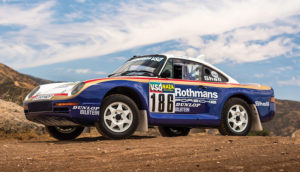
1986 Winner Porsche 959 turns Dakar Rally into high-speed race Source::Auto Zeitung
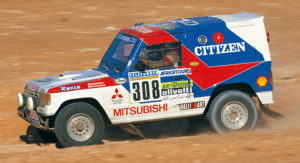
Pajero prototype 1986 model
But this request did not provide any base layout or output style, let alone a schedule. We were puzzled by the broad generality of the request but interpreted it to mean “We will leave everything to you, so please send us a design with good aerodynamic performance as soon as possible” Assuming the Paris-Dakar Rally to be held at the beginning of the following year, there would be only about four months or less. Considering the period for prototype fabrication and test driving, even we, amateurs in rallying, could imagine that there was not enough time to complete the project. Since we were receiving this work indirectly, we could not foresee when we would hear back from Sonauto (France), the company responsible for prototype production, even if we asked them various questions. Therefore, we decided to design the car in the shortest possible time and start the study by formulating our own preconditions and quickly get to work.
This work had to be completed in a short period to minimize the impact on our main business, the 2nd-gen. Pajero. Therefore, the schedule was set at 1.5 months, including the wind tunnel test, which was to be the key element of the project. We estimated that a basic layout drawing of the second-generation Pajero Short (Wide) would be a good base for the design plan, and the final output was a 1/4 model and an exterior drawing that could be done in a short period.
―― 2-hour brainstorming
The 1.5 months set for the project did not include any design refinements during the course so there was no spare time at all. Normally, we would have first set aerodynamic targets with the Functional Test Section (hereafter referred to as “Test Section”) in charge of aerodynamic testing, and then developed ideas based on a preliminary outlook for a shape that would meet these targets. However, we judged that we would not make it in time. Although it was a rough work, we tentatively set up aerodynamic improvement ideas and basic form, which we would brush up at the wind tunnel test site together with the Test Section. Now, just as we were about to get down to work, Aoki, a designer from the other group, walked by, and we involved him in the brainstorming session on the spot, as he was always up for anything. We generated ideas in two hours and made three rough sketches based on the ideas. The design theme was “F1 in the desert,” surpassing the likes of Porsche and Peugeot in the Paris-Dakar Rally.
The main goal was to pursue aerodynamic performance in order to increase high-speed performance. The specific measures were aimed at reducing aerodynamic drag by reducing the frontal projected area by lowering the overall height, sloping down the rear of the roof to lower the air separation point at the end of the body, and increasing the slope of the nose and windshield. Furthermore, by combining a large rear wing (angle variable according to driving conditions) and supporting vertical tail wings on either side, the car looks like a two-box Pajero in the side view but is designed for high-speed driving. We came up with this based on our limited aerodynamic knowledge and wild guesses. We thought we were bold enough to go ahead and incorporate the approved 2nd generation Pajero design motifs around the front. However, we were disappointed that no one, inside or outside the company, noticed this when the car was launched! It was the designer’s self-indulgence.
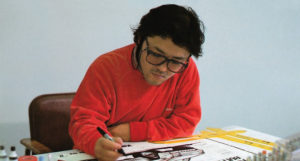
Writer drawing rough sketch
―― Support from partner companies
We were busy putting the finishing touches to the 2nd gen. Pajero, so we asked Nimura Design, our partner company, to render the three rough sketches we made. For the colors and graphics, we asked them to incorporate the image of the 1987 model. The two of us had already decided on our main goal tacitly, and as the renderings were as good as we had hoped, it was easy to set the direction to go. After a check by the chief designer Oshima, we started work on the next drawing.

Selected rendering sketch

We made a rough tape drawing of just the silhouette on the basic layout drawing of the 2nd gen Pajero Short (Wide), and based on this we asked Nimura Design again to make a drawing for the 1/4 model. We should have done this work ourselves, but we had no choice but to do it this way, considering how busy we were with our main business. Then, based on the finished drawings, an aerodynamic test model and a design study model were commissioned to Shinko Models. We also asked Shinko Models to reflect the color and graphics of the renderings in this model, as they were quite good. In this way, we were able to proceed with the work in the shortest possible time. This was thanks to external backup.
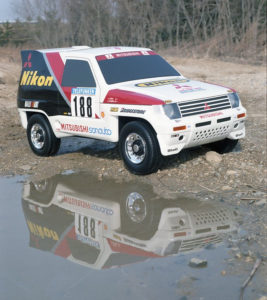
Scale model for design study

―― Painstaking wind tunnel test
After checking the completed model, we finally started aerodynamic testing. The model, clay and tools were brought to the wind tunnel testing site and measurements began together with Kameyama of the Test section. Each time a measurement is made, the shape is corrected on the spot many times, a process that requires a lot of patience. One of the most memorable cases was the removal of a strut that was thought to be necessary to support the large rear wing but turned out to be a major source of resistance. We also modified the shape of the front air dam and other areas, and thanks to a lot of trial and error, we were able to improve the Cd value by 20% compared to the 2nd-gen Pajero. We started this work based on our rough ideas, but in the end, we worked together with the test section to produce the output in one stroke. We were grateful for Kameyama’s cooperation in improving the aerodynamics.


―― Photo from Sonauto
When the aerodynamic tests were finished, time was already running out, so the drawings were revised based on the test results and sent directly to Sonauto with the 1/4 model to finish the job. After that, there was no correspondence from Sonaut, and when we had almost forgotten about it, we happened to have a chance to look at the photo of the prototype being built. We were relieved to learn that the drawing and model had arrived safely and were thrilled to know that the fabrication was progressing as we had intended. All that remained was to win the overall Paris-Dakar championship.
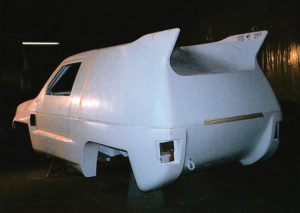
―― 10th Paris-Dakar Rally
The rally started in Paris on New Year’s Day 1988 and was a 22-day race covering 13,000 km to Dakar, the capital of Senegal. The result was an overall victory for Juha Kankkunen, driving a Peugeot 205. Mitsubishi’s Kenjiro Shinozuka, driving an ’87 model, finished second overall. The ’88 model, for which we had high hopes, ended up retiring, which was a disappointing result for us. We also felt sorry that we could not honestly rejoice at Shinozuka’s excellent performance. (Mitsubishi Motors/Dakar Rally 1988)
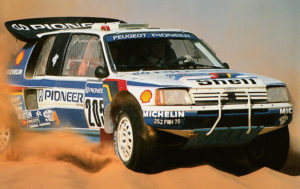
Juha Kankkunen’s winning Peugeot 205

Kenjiro Shinozuka’s Pajero Prototype 1987 model, finishing in 2nd place
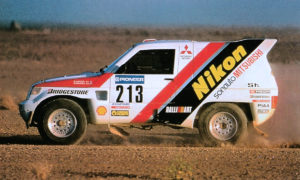
Pajero prototype 1988 model
―― Facing the car
After the rally, the 1988 model was sent to Mitsubishi’s Vehicle Testing Department to take data for the next phase of development. So we were able to borrow the car for a day and bring it into the Design Department for review. That was the first time we saw the actual car. At first glance, we were impressed by how well our design had been realized and surprised by the high skills of the French modelers. The way the spare tire was placed in the boot compartment, making effective use of the limited space available, left us thinking, “Oh, that’s how they put the spare tire in”.
We were also amazed when we saw the front wheel cutouts that had nothing to do with our design intent, but when we thought that this was a treatment that had no impact on driving performance, we thought that it was clear and different from mass-production car design. However, on closer look, the overall feeling of solidity was lacking compared to the image in the sketch, and I thought it needed to be more robust. Although this was not possible in reality, I thought that it would certainly improve if it was refined once more.


―― Special task of prototype design
I think the keyword for this special assignment was ‘discretion’. With no detailed information from the requester, it was difficult to ask our supervisor to make a judgment, and the only way to organize this urgent task was to leave everything to us. We are grateful to Chief Designer Oshima, who understood the special nature of this work and allowed us to do as we wished, as well as the support of the Test section and partner companies, for enabling us to achieve the desired goals.
I also wondered: how should designers be involved, as prototypes are all about winning? I still don’t know how we could have designed a car that would have won. However, although we missed the victory with the 1988 model, we were happy that our work was carried over to subsequent prototype designs, and above all, we were lucky to have a job that we rarely get to do, and enjoy designing a lot.
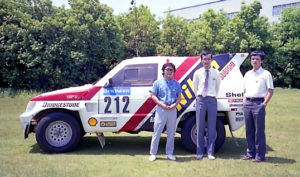
Design team, writer (left) Masao Oshima (center) Taketoshi Abe (right)
March 2023